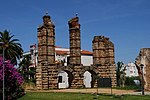Augusta Emerita

Augusta Emerita, also called Emerita Augusta, was a Roman colonia founded in 25 BC in present day Mérida, Spain. The city was founded by Roman Emperor Augustus to resettle Emeriti soldiers from the veteran legions of the Cantabrian Wars, these being Legio V Alaudae, Legio X Gemina, and possibly Legio XX Valeria Victrix. The city, one of the largest in Hispania, was the capital of the Roman province of Lusitania, controlling an area of over 20,000 square kilometres (7,700 sq mi). It had three aqueducts and two fora. The city was situated at the junction of several important routes. It sat near a crossing of the Guadiana river. Roman roads connected the city west to Felicitas Julia Olisippo (Lisbon), south to Hispalis (Seville), northwest to the gold mining area, and to Corduba (Córdoba) and Toletum (Toledo).Today the Archaeological Ensemble of Mérida is one of the largest and most extensive archaeological sites in Spain and a UNESCO World Heritage Site since 1993.
Excerpt from the Wikipedia article Augusta Emerita (License: CC BY-SA 3.0, Authors, Images).Augusta Emerita
Calle Poeta Deciano, Merida San Antonio
Geographical coordinates (GPS) Address Nearby Places Show on map
Geographical coordinates (GPS)
| Latitude | Longitude |
|---|---|
| N 38.916666666667 ° | E -6.3333333333333 ° |
Address
Calle Poeta Deciano
Calle Poeta Deciano
06800 Merida, San Antonio
Extremadura, Spain
Open on Google Maps











